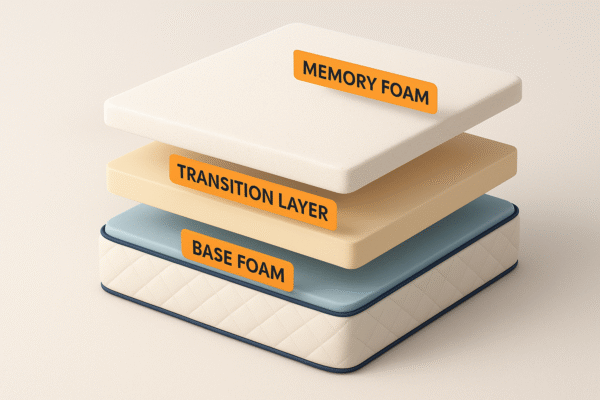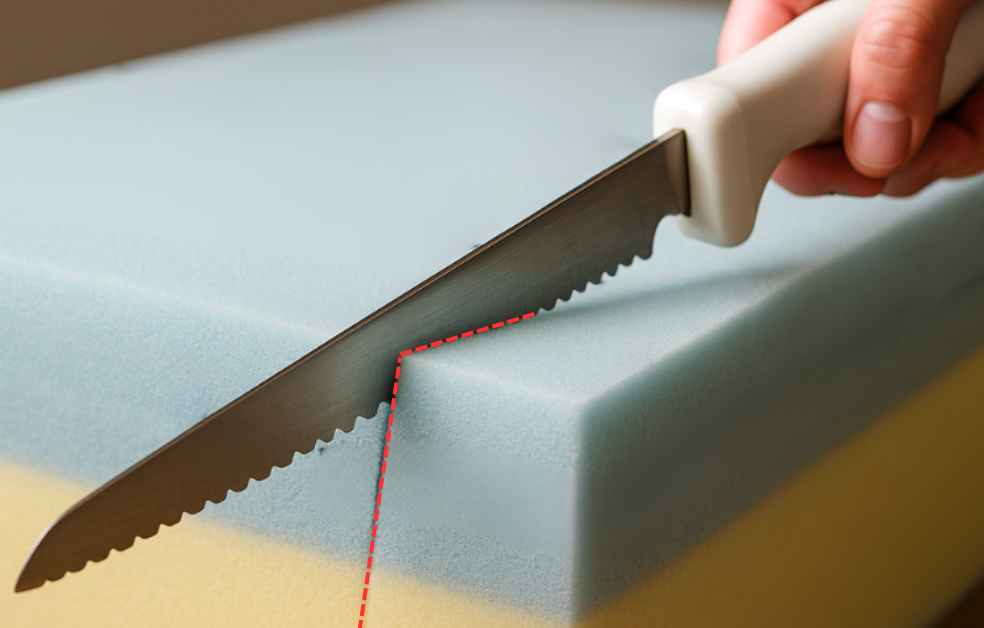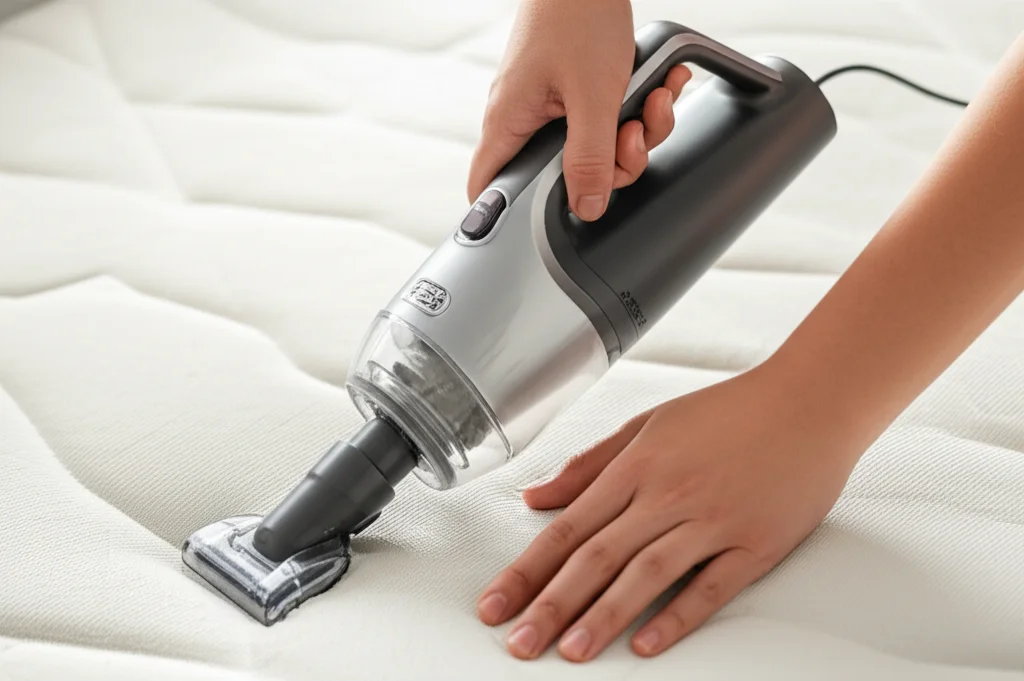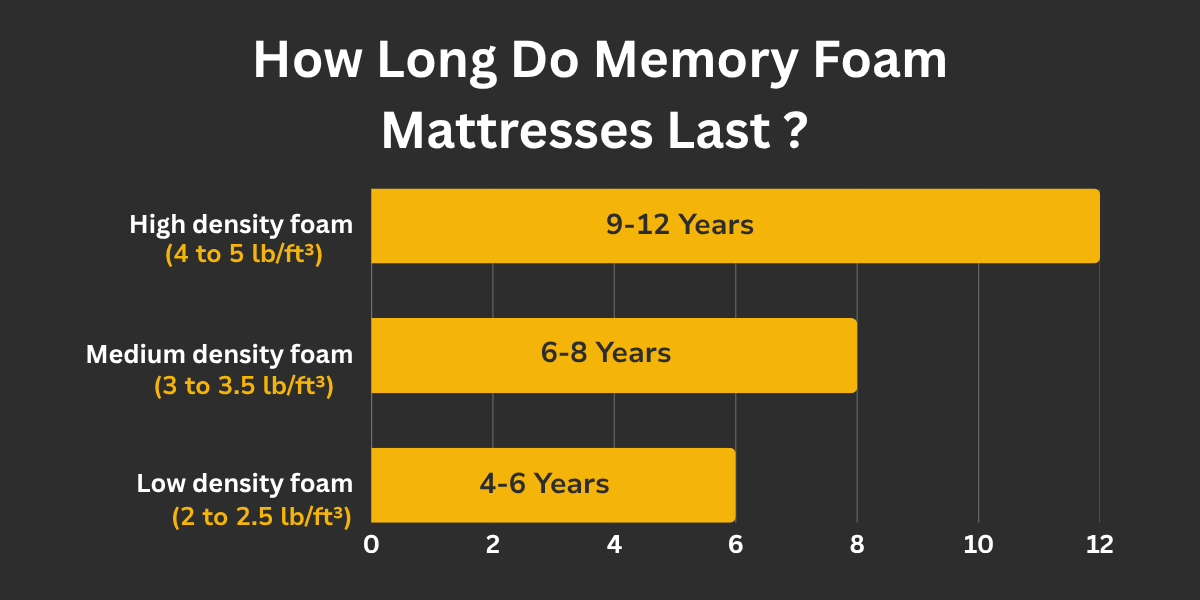“A third of your life is spent sleeping so why not make it count?”
If you’ve ever wondered why memory foam mattresses are all the rage, you’re not alone. From orthopedic support to motion isolation, memory foam has transformed modern sleep. But are they really worth the hype in 2025?
In this detailed guide, I’ll walk you through what a memory foam mattress really is, how it works, its pros and cons, different types, for whom it’s best for, price ranges, and how to choose the perfect one according to your sleep needs.
Whether you’re upgrading your current mattress or buying your first, this guide will help you get to a decision whether its for you or not.
What Is Memory Foam & How it Ended up in our Bedrooms?
Memory foam mattresses weren’t always in bedrooms.
Back in the ’60s, NASA created this funky material to cushion astronauts during takeoff. It was made to absorb shock, reduce pressure, and keep them safe in their seats. Years later, hospitals started using it for bed-ridden patients.
Eventually, someone had the brilliant idea to bring it into our homes.
So what makes it different from other beds?
When you lie down, memory foam responds to your body heat and weight. It softens around pressure points like your hips and shoulders and stays firmer where you need support. That’s why it feels like it’s “hugging” you.
I switched after waking up sore one too many times. Traditional spring mattresses just weren’t cutting it.
With memory foam, I noticed less tossing, no more waking up every time my partner moved, and honestly just better sleep overall.
That’s why it took off in consumer markets: it solved problems people didn’t even realize were fixable.
As a result, now you see memory foam everywhere, in mattresses, pillows, even sofas.
What's Exactly Inside a Memory Foam Mattress? (Construction)

So here’s what I learned when I finally cared what I was sleeping on.
Memory foam is basically polyurethane foam with viscoelastic chemicals added. Those extra chemicals are what make it feel slow, soft, and body-hugging.
You press in, it molds; you get up, it recovers gradually.
Basically it remembers the shape of your body for a short time after the pressure is released. And that’s why it’s called so!
A memory foam mattress is kind of like a giant sandwich made just for your body. The top layer is super soft and squishy, like a cozy sponge that remembers the shape of your body.
Underneath that is a middle layer that helps balance how much you sink in, and at the very bottom is a strong layer that holds everything up so you don’t feel like you’re sinking into a hole.
Some mattresses even have tiny gel beads or cool stuff like copper to stop you from getting too hot at night. It’s like sleeping on a comfy cloud that gives you a hug!
I’ve tried the one with gel it definitely helped with heat.
Pro Tip: Look for the CertiPUR-US® label. That tells you the foam is made without ozone depleters, heavy metals, or other nasty stuff. My first mattress didn’t have it, and the smell lasted forever.
How does a Memory Foam Mattress Work?
So here’s the deal: memory foam is basically made from something called viscoelastic polyurethane.
That’s a mouthful, but all you really need to know is – it’s temperature sensitive and pressure-responsive.
That means when you lie down, your body heat softens the foam, and it molds around your shape. Kinda like when you press your hand into a bowl of cookie dough ,your handprint stays for a second before slowly rising back.
Now, I used to think this “sinking in” feeling was bad for my back. In fact, my first memory foam mattress was a cheap one off a random online sale. Big mistake.
It didn’t have any support layers underneath, so after a week, my lower back was crying for help. I learned (the hard way) that a good memory foam mattress isn’t just about squishiness. It’s a layered system.
Usually, a proper memory foam mattress has a top comfort layer (that contouring stuff), followed by one or two support layers underneath.
These firmer layers help keep your spine aligned. So even if you sleep on your side, like me, your hips and shoulders sink in just enough without throwing your whole posture outta whack.
Pro tip: If you’re shopping for one, check if it mentions “zoned support” or “high-density foam core.” That’s the stuff that really keeps the mattress from becoming a hammock over time.
And heat. Let’s talk about heat. Classic memory foam used to get ridiculously warm. I’d wake up sweating like I ran a marathon in my sleep.
But newer models (especially those labeled “gel-infused memory foam” or “open-cell structure”) help with temperature regulation. They don’t feel like you’re sleeping in a toaster.
Here’s a weird tip I found useful: if you live somewhere cold, your mattress might actually feel firm at first.
Give it a few minutes. It softens with your body heat. My buddy in Colorado thought he got a lemon until I explained that to him.
It reduces motion transfer, too – So if you’ve got a partner who tosses and turns like a fish outta water, it won’t bother you as much.
To wrap it up: if you’re considering a memory foam mattress, make sure it has a good support core, check the density (anything above 3.5 lbs/ft³ is decent), and go for something breathable.
What are the Pros of a Memory Foam Mattress?
There’s a reason memory foam has become the go-to for people who take sleep seriously.
For me, the biggest benefit was how it contours to the body.
One of our Clients used to wake up with soreness in their hips and shoulders, but after switching, the pressure points just melted away.
If you share the bed, motion isolation is another major win. I don’t feel it anymore when my partner gets up in the middle of the night, which means fewer disruptions and deeper sleep.
One of the most appreciated qualities is that it’s hypoallergenic, which is great if you’ve got allergies. Because it keeps away dust mites and mold, many of our clients have told us that they now woke up with a fewer sinus problems.
Another perk? Durability. A quality foam mattress can easily last 8 to 10 years with minimal sagging. Mine’s still in great shape after years of nightly use.
And if you’ve got an adjustable bed frame, memory foam bends and flexes without losing support.
It adapts easily while still giving you that stable, cradled feeling.
What are the Cons of a Memory Foam Mattress?
I’ll be honest, memory foam isn’t perfect. There are a few things that caught me off guard early on.
The biggest one?
Heat retention. Traditional memory foam can retain body heat, and if you’re a hot sleeper like me, it gets uncomfortable fast. I had to add a cooling mattress pad before upgrading to a gel-infused version.
Then there’s the Off-Gassing.
When I first unboxed my mattress, the chemical smell hit me hard. It took a couple of days to fade, even with windows open.
Another issue is the weight. Memory foam mattresses are heavy and awkward to move, especially if you’re setting one up solo. Flipping or rotating it isn’t exactly easy.
Some people also feel the “sinking” sensation is too much. If you like a bouncy bed or sleep on your stomach, it might not be your thing. I adjusted over time, but it’s worth considering.
Also the Slow Recovery Time. The foam slowly rebounds after pressure is released. Some people find it cozy, while others say it feels a bit like quicksand.
Finally, quality comes at a cost.
Higher-end models can be pricey, and the cheaper ones don’t always hold up. So, it’s one of those “you get what you pay for” deals.
What are the Multiple Types of Memory Foam Mattress?
- Traditional Memory Foam: This is the OG memory foam. It gives you that deep, body-hugging sink that made the material famous. Downside? It tends to trap heat, so if you sleep hot, maybe skip this one.
- Gel-Infused Foam: Manufacturers added cooling gel beads to help pull heat away from the body. I’ve tried one of these, and it definitely felt cooler than my old one. It’s a solid pick if you sleep warm but love that classic foam feel.
- Open-Cell Memory Foam: This one has a more breathable structure that allows for better airflow. It feels a bit lighter and more responsive than traditional foam. Good balance between comfort and cooling.
- Plant-Based Memory Foam: Made with a portion of natural oils instead of 100% synthetic chemicals. It’s usually more eco-friendly and has a quicker bounce-back. I haven’t used one long-term, but the idea of less off-gassing is appealing.
- Hybrid Memory Foam: Combines foam layers with coils or sometimes latex. These give you the contouring of foam with added support and bounce from the springs. Great if you want pressure relief but don’t like sinking too far in.
"Your mattress is the most important piece of furniture in your home."
Dr. Michael Breus, Board-certified Sleep Specialist
How Much Does a Memory Foam Mattress Cost?
Price Factors like Brand name, foam density, certifications, and warranty terms all play into the cost. Also, the U.S. made models also tend to cost more.
Memory foam mattresses come in all price ranges, and it can get overwhelming fast. Here’s how I break it down:
- Budget Range ($200–$600): These are your entry-level options. They usually have lower density foam and fewer layers. It’s great for guest rooms or short-term setups, but not always the best for long-term back support.
- Mid-Range ($600–$1,200): This is the sweet spot for most folks. Expect better cooling features, solid foam construction, and a more supportive feel overall. Mine falls in this range and has held up great for years.
- Premium Range ($1,200–$2,500+): Here you get zoned support, luxury covers, and often extended warranties. It’s an investment, but only if you value long-term comfort, it can be worth every penny.
Bonus Tip: Always check the trial period, return policy, and whether shipping is included. I once skipped that part and ended up paying for return shipping lesson learned.
How to Choose the Right Memory Foam Mattress for you?
Picking a memory foam mattress isn’t just about what feels good in the store.
About 10 years ago, I learned that the hard way when I bought a soft mattress without checking the specs, lasted a year before it gave out.
Start with foam density. Higher-density foams (around 5 lb/ft³) usually last longer and offer better support. They feel firmer but hold up better over time.
Next up: firmness level. I’m a side sleeper, so soft to medium works best for me. If you’re a combo sleeper, go medium. Back or stomach sleepers usually need something firmer to keep the spine aligned.
Cooling needs matter too. Traditional memory foam can sleep hot, so look for gel-infused or open-cell models if you run warm.
Trust me, you’ll notice the difference in the summer.
Again, Always check for certifications like CertiPUR-US®. They confirm the foam is free from harmful chemicals and made responsibly. It’s one of those little things that make a big difference.
And don’t forget the trial and warranty. Most good brands offer 90 to 365 nights to test it at home, plus a 10-year warranty.
If you skip those, you could end up stuck with something your back hates.
Who Should and Shouldn’t Buy a Memory Foam Mattress?

Memory foam isn’t a one-size-fits-all deal. For some folks, it’s a dream. For others, not so much.
It’s ideal for side sleepers and people who deal with chronic pain. The way it contours around pressure points like shoulders and hips makes it super supportive without being rigid.
Couples too love it because of the motion isolation. You can roll around without waking the other person.
And if you’ve got allergies? It’s a great pick – hypoallergenic and resistant to dust mites.
But still, it’s not for everyone. If you’re a hot sleeper, memory foam can feel like a heat trap – unless you go for models with cooling gel or open-cell foam.
And if you like a bed with some bounce or need an ultra-firm surface, this probably won’t hit the mark. Memory foam has a slower response that some people just don’t like.
So before buying, think about your sleep habits and preferences. You can take our mattress quiz to help you find your ideal mattress in less than a minute.
How to Maintain & make a Memory Foam Mattress Last Longer?
Memory foam mattresses don’t need a ton of upkeep, but a little care goes a long way. Here’s what I’ve picked up from years of using one:
- Always use a mattress protector. It keeps sweat, spills, and dust from soaking into the foam. I skipped this once and regretted it when a coffee stain wouldn’t come out.
- Spot clean using mild detergent and air-dry completely before putting the sheets back on. No harsh scrubbing as foam is delicate.
- Rotate the mattress every 6 months. It helps prevent uneven wear and sagging, especially if you sleep in the same spot every night like I do. Works like magic.
- Avoid jumping or bending the mattress. Memory foam isn’t built for acrobatics or folding up like a taco or you’ll damage the structure.
- Replace it every 8 to 10 years. If it starts sagging or you wake up sore, that’s your sign.
A little regular care keeps the mattress feeling fresh and supportive for years.
Final Thoughts
A memory foam mattress can be a game-changer, if you choose wisely. With its pressure relief, comfort, and motion isolation, it’s a top choice in 2025 for a reason.
But as you’ve seen, not all foams are created equal.
So, the key is to first understand your unique sleep needs, then invest in a mattress that meets those requirements – whether it’s memory foam or another type.



